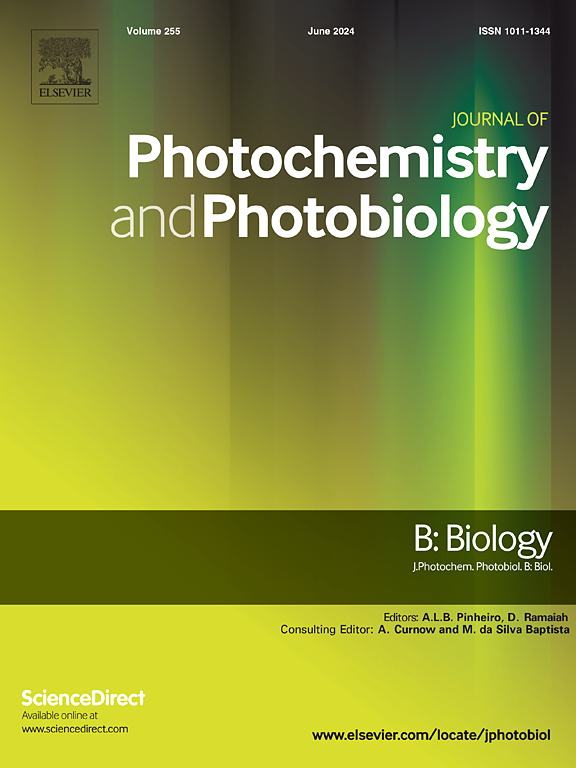Prolonged DNA damage at suberythemal UV dose – Dependency on skin type and age
IF 3.9
2区 生物学
Q2 BIOCHEMISTRY & MOLECULAR BIOLOGY
Journal of photochemistry and photobiology. B, Biology
Pub Date : 2025-06-27
DOI:10.1016/j.jphotobiol.2025.113206
引用次数: 0
Abstract
Ultraviolet radiation (UVR) is the primary risk factor for skin cancer, inducing DNA damage such as cyclobutane pyrimidine dimers (CPD) and pyrimidine–pyrimidone (6–4) photoproducts. DNA repair is influenced by age and skin type. Aging reduces repair capacity, leading to accumulated DNA damage, while darker skin provides some protection through melanin's UV-absorbing properties. However, repair dynamics in darker skin remain poorly understood.
This pilot study aimed at evaluating the influence of age and skin pigmentation on UV-induced DNA damage and repair efficiency in both ex vivo skin samples and healthy volunteers. Excised skin samples were categorized by pigmentation and age: light skin (types I–II, 18–50 years), light skin (55–70 years), and dark skin (types IV–V, 18–50 years). Samples were irradiated with fixed suberythemal doses, and biopsies were collected immediately post-irradiation to evaluate DNA damage and p53 expression. Healthy volunteers, grouped similarly (n = 6 per group), received ¼ minimal erythema dose (MED, determined individually), with biopsies taken 24 h and 7 days after irradiation. For melanin dependence, DNA damage was also determined directly after irradiation.
Older individuals exhibited greater DNA damage and reduced repair capacity. Dark skin showed initial melanin-mediated protection; but a first hint of greater residual damage was observed 24 h after irradiation compared to light skin, probably due to delayed repair activation and melanin photosensitization. However, the high variability in dark skin underscores the need for larger, diverse studies to better understand pigmentation-related differences in UV response and DNA repair mechanisms. By day seven, CPD clearance was observed in dark skin.
These findings highlight that even suberythemal UVR induces photodamage, with repair kinetics influenced by age and pigmentation.

红斑下紫外线剂量延长DNA损伤-与皮肤类型和年龄有关
紫外线辐射(UVR)是皮肤癌的主要危险因素,可诱导DNA损伤,如环丁烷嘧啶二聚体(CPD)和嘧啶-嘧啶(6-4)光产物。DNA修复受年龄和皮肤类型的影响。衰老降低了修复能力,导致DNA损伤的累积,而深色皮肤通过黑色素吸收紫外线的特性提供了一些保护。然而,深色皮肤的修复动力学仍然知之甚少。本初步研究旨在评估年龄和皮肤色素对体外皮肤样本和健康志愿者紫外线诱导的DNA损伤和修复效率的影响。切除的皮肤样本按色素沉着和年龄分类:浅色皮肤(I-II型,18-50岁)、浅色皮肤(55-70岁)和深色皮肤(IV-V型,18-50岁)。样品以固定的红斑下剂量照射,照射后立即收集活检以评估DNA损伤和p53表达。健康志愿者,分组相似(每组n = 6),接受¼最小红斑剂量(MED,单独确定),照射后24小时和7天进行活检。对于黑色素依赖,辐照后也直接测定DNA损伤。老年人表现出更大的DNA损伤和更低的修复能力。深色皮肤初步表现出黑色素介导的保护作用;但与浅色皮肤相比,照射后24小时观察到的第一个迹象是更大的残余损伤,可能是由于修复激活和黑色素光敏化延迟。然而,深色皮肤的高度可变性强调了需要进行更大规模、更多样化的研究,以更好地了解色素在紫外线反应和DNA修复机制中的相关差异。到第7天,深色皮肤中观察到CPD清除。这些发现强调,即使是红斑下的紫外线也会引起光损伤,修复动力学受年龄和色素沉着的影响。
本文章由计算机程序翻译,如有差异,请以英文原文为准。
求助全文
约1分钟内获得全文
求助全文
来源期刊
CiteScore
12.10
自引率
1.90%
发文量
161
审稿时长
37 days
期刊介绍:
The Journal of Photochemistry and Photobiology B: Biology provides a forum for the publication of papers relating to the various aspects of photobiology, as well as a means for communication in this multidisciplinary field.
The scope includes:
- Bioluminescence
- Chronobiology
- DNA repair
- Environmental photobiology
- Nanotechnology in photobiology
- Photocarcinogenesis
- Photochemistry of biomolecules
- Photodynamic therapy
- Photomedicine
- Photomorphogenesis
- Photomovement
- Photoreception
- Photosensitization
- Photosynthesis
- Phototechnology
- Spectroscopy of biological systems
- UV and visible radiation effects and vision.

 求助内容:
求助内容: 应助结果提醒方式:
应助结果提醒方式:


